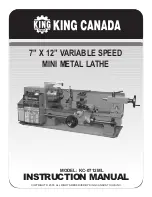
model g0694 (mfg. since 1/09)
-31-
Using Backing Block
if wood screws cannot be placed in the workpiece,
then the faceplate can be mounted on a backing
block that is glued to the workpiece (see
figure
36 for an example).
Outboard Turning
When the workpiece is larger than 20" in diam-
eter, mount it on the outboard side of the lathe.
to do this, swap the faceplate and handwheel
positions as shown in
figure 37 (refer to Installing
faceplate/Handwheel on Page 24 for detailed
instructions).
Keep the lathe chisel against the tool rest the
ENTIRE time you are cutting or when feeding
the chisel into the workpiece. Otherwise, the
spinning workpiece could knock the chisel
out of your hands or pull your hands into
the workpiece, resulting in serious entangle-
ment or impact injuries.
figure 36. typical attachment of faceplate to
workpiece (shown with backing block).
To mount your workpiece to a backing block:
1. make the backing block from a piece of scrap
wood that is flat on both sides.
2. Locate and mark the center of both the
workpiece and backing block.
3. drill a
1
⁄
4
" hole through the center of the back-
ing block.
4. Looking through the hole in the backing block
to line up the center with the workpiece,
glue and clamp the backing block to the
workpiece.
Note:
Allow the glue to cure according to the
manufacturer's instructions.
5. attach the faceplate as detailed in the previ-
ous subsection.
figure 37. spindle setup for outboard turning.
Face plate mounted on outboard
side of the headstock.
handwheel mounted on inboard
side of the headstock.
as well, you must use the outboard tool rest (refer
to
Outboard Tool Rest on Page 21 for detailed
instructions).
When outboard turning, rotate the workpiece
by hand before connecting the machine to
power to make sure that it will not come
in contact with any obstacle. Otherwise,
it could break apart during operation and
cause serious impact injuries.















































